Method For Fabricating A Curved Beam From Composite Material
a composite material and beam technology, applied in the field of beam fabrication, can solve the problems of degrading the strength of the finished beam, wasting a lot of material, and difficult to get a laminate composed of layers of fibers with different fiber directions to follow the curvature, so as to achieve good strength and reduce material was
- Summary
- Abstract
- Description
- Claims
- Application Information
AI Technical Summary
Benefits of technology
Problems solved by technology
Method used
Image
Examples
Embodiment Construction
[0013] The invention will be described below based on an embodiment in which the curved beam is shaped as a C-beam. It will be apparent that the same fabrication method can also be used for hat-shaped beams, Z-beams and I-beams.
[0014]FIG. 1 shows a perspective view of a male tool with a radius of curvature R. The tool can preferably consist of a homogeneous metal tool. Other materials and structures are of course also possible. The method according to the invention has been tested successfully using curve radii in excess of 2 meters and beam heights of up to 150 mm. It will be apparent to one skilled in the art that larger radii make it possible to work with higher beam heights while, in the same way, lower beam highs make it possible to work with smaller curve radii.
[0015]FIG. 2 depicts the shaping of a laminate 2 on a male tool 1 according to a prior art method. The laminate 2 is laid in contact with an intermediate web on the tool. The fiber composite laminate 2 is then brought...
PUM
| Property | Measurement | Unit |
|---|---|---|
| heights | aaaaa | aaaaa |
| radius of curvature | aaaaa | aaaaa |
| density | aaaaa | aaaaa |
Abstract
Description
Claims
Application Information
 Login to View More
Login to View More - R&D
- Intellectual Property
- Life Sciences
- Materials
- Tech Scout
- Unparalleled Data Quality
- Higher Quality Content
- 60% Fewer Hallucinations
Browse by: Latest US Patents, China's latest patents, Technical Efficacy Thesaurus, Application Domain, Technology Topic, Popular Technical Reports.
© 2025 PatSnap. All rights reserved.Legal|Privacy policy|Modern Slavery Act Transparency Statement|Sitemap|About US| Contact US: help@patsnap.com



